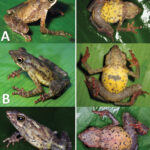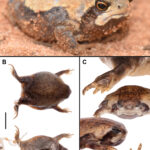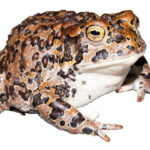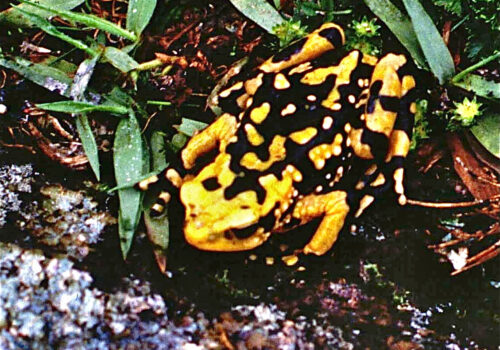- Introduction: A Gem Amid the Misty Mountains
- Taxonomy and Classification: Where the Harlequin Fits In
- Natural Habitat: A Life in the Clouds
- Physical Characteristics: A Vibrant Jewel of Evolution
- Behavior and Life Cycle: Secrets Along the Streambanks
- Ecological Role: Guardians of the Mountain Ecosystem
- Threats and Conservation Status: A Battle for Survival
- Cultural and Scientific Significance: Beyond Beauty
- Conclusion: Protecting Peru’s Harlequin Legacy
Introduction: A Gem Amid the Misty Mountains#
Hidden among the lush, cloud-crowned mountains of Peru lives a remarkable amphibian—one whose vivid hues and unique habits evoke fascination and admiration. The Peruvian Harlequin Frog, scientifically recognized as Atelopus peruensis, is more than just a vibrant marvel of nature; it serves as a living indicator of ecological health, a messenger from remote highland streams alerting us to subtle environmental changes. This species, with its striking colors and fascinating ecology, captivates scientists, nature enthusiasts, and conservationists alike, yet remains surprisingly enigmatic and understudied.
Join me today on a virtual expedition through verdant forests, bubbling mountain streams, and mist-shrouded corridors, as together, we uncover the compelling story and critical importance of the incredible Atelopus peruensis.
Taxonomy and Classification: Where the Harlequin Fits In#
The Peruvian Harlequin Frog belongs to the Bufonidae family, a group we commonly recognize as true toads. Within this expansive family nestles the genus Atelopus, known informally as Harlequin frogs, beloved for their vibrant coloration patterns and intriguing behavioral traits. Classified scientifically as Atelopus peruensis, this species joins a distinctive lineage recognized for their bold contrasting colors, small to medium-sized bodies, and specialized adaptations to rapidly flowing mountainous environments.
The genus name Atelopus, meaning “imperfectly developed foot,” references their unusual structure adapted perfectly for traversing slippery, rocky surfaces. The Harlequin frogs, numbering approximately a hundred known species, are ecological specialists renowned for their crucial role as indicators of ecosystem integrity—sensitive canaries in the environmental coal mine.
Natural Habitat: A Life in the Clouds#
Geographical Range and Distribution#
Atelopus peruensis is endemic primarily to high-altitude cloud forests and montane streams within the Andean regions of north-central Peru. Their limited and highly specialized range centers around certain isolated highland ecosystems, often between altitudes of 2,400 and 3,000 meters above sea level. Regions such as the Cordillera Oriental or the lush slopes surrounding the Marañón river valley harbor these elusive populations.
The Secretive Realm of the Harlequin Frog#
Imagine standing amid dense foliage kissed by perpetual mist, where the air is thick with the scent of damp moss and decaying leaves, and clear water tumbles gently over ancient stones. Here, beneath layers of ferns and bromeliads cloaking the branches, Atelopus peruensis blends seamlessly into its environment. They prefer fast-flowing streams—the lifelines of misty Andean forests—dwelling along streambanks and adjacent leaf litter, their territories often shaded by thick canopies that moderate temperature, humidity, and sunlight exposure.
These habitats provide ideal conditions for their sensitive amphibian skin, as the moisture-laden air and consistent temperature protect them from dehydration. Their survival is intricately bound to the cool, pristine waters where they breed and their tadpoles develop, intertwining the frog’s existence with the integrity of mountain watersheds.
Physical Characteristics: A Vibrant Jewel of Evolution#
The Peruvian Harlequin Frog dazzles keen eyes with its remarkable coloration—bold contrasts of vibrant yellows, stark blacks, and mottled greens. These vivid patterns are nature’s warnings, signaling potent natural toxins secreted from specialized glands beneath the frog’s skin. Unlike dull-colored species relying solely on evasion, Atelopus peruensis literally wears its deterrence, announcing boldly to would-be predators: proceed with caution.
Individuals are moderately sized, generally measuring just 30 to 50 millimeters in length. Their bodies are slender yet robust, delicately adapted to traverse the tricky terrains they inhabit. The streamlined limbs and dexterous feet display specialized adaptations that allow these frogs to cling tenaciously to wet rocks and logs bordering rushing mountain waters.
Such visibly pronounced adaptations come together as evolutionary solutions uniquely suited to a challenging mountainous environment, where agility, grip, and toxic defense have shaped an extraordinary lifestyle.
Behavior and Life Cycle: Secrets Along the Streambanks#
An Amphibious Feast—Dietary Habits#
Atelopus peruensis sustains itself primarily through a diet of small invertebrates—tiny beetles, ants, termites, and other forest floor insects. Using keen eyesight and quick reflexes, they ambush prey within their leafy domain. Discerning observers may watch them boldly hunting on damp leaves or moss-covered stones along streams, patiently awaiting prey before striking suddenly with impressive precision.
The Intricacies of Reproduction#
Reproduction is timed with seasonal environmental cues—typically wet-period streams offering optimal conditions. Male frogs congregate near rushing waters, advertising their fitness through faint but distinct calls heard through dense vegetation. Unlike booming tropical frog choruses, Atelopus peruensis’ songs are soft, melodious, borne subtly above the rustling leaves and bubbling waters—a gentle serenade echoing quietly in the mountains.
Females arrive, selecting partners based on call, territory, and visual cues, before laying egg masses under rocks or plant debris, sheltered from turbulent currents but still exposed to clean, oxygenated water. Tadpoles hatch, resilient and distinctly adapted for fast-moving currents; they anchor themselves firmly to submerged substrates, grazing algae and streambiofilm ecosystems as they slowly grow towards their transformative metamorphosis into adulthood.
Ecological Role: Guardians of the Mountain Ecosystem#
The Harlequin frog is not merely a colorful curiosity—it occupies a pivotal role in its high-altitude ecosystem. A key predator of forest-floor and aquatic insects, it keeps insect populations balanced while simultaneously providing crucial nutrients back to the terrestrial ecosystem as prey for snakes, birds, or mammals impervious or resistant to their toxins.
Most critically, their exceptional environmental sensitivity renders them vital indicator species, with population declines often signaling environmental distress caused by pollutants, habitat alteration, or emerging diseases. This sentinel role underscores their complex ecological interdependence with broader ecosystem equilibrium.
Threats and Conservation Status: A Battle for Survival#
Sadly, the stunning beauty of Atelopus peruensis masks a harsh reality. Like so many amphibians worldwide, declines severely threaten their long-term survival. Habitat destruction caused by deforestation, agriculture, mining activities, and the added pressures from climate change impose alarming threats to their limited range’s habitats.
Additionally, chytridiomycosis—a devastating fungal disease caused by Batrachochytrium dendrobatidis, which spreads rapidly among cold, moist ecosystems—is crippling Harlequin frog populations across Latin America. Current documented declines prompted the International Union for Conservation of Nature (IUCN) to classify this treasured amphibian as critically endangered, highlighting the pressing need for directed conservation efforts to preserve both individual species and overarching habitats.
Thankfully, conservationists, local communities, NGOs, and governmental bodies are joining hands to protect critical ecosystems. Initiatives include habitat restoration, captive breeding programs designed to boost wild populations, disease monitoring, and community-driven educational programs aimed at building diverse support for frog-centered conservation strategies.
Cultural and Scientific Significance: Beyond Beauty#
Beyond ecological necessities, Atelopus peruensis symbolizes cultural identity within Peruvian highland societies, appearing in local folklore and traditional ecological knowledge. Symbolically associated with water purity and environmental health, its presence or disappearance marks subtly significant cultural shifts, reminding communities of their connectedness to nature.
Scientifically, the species has enhanced our understanding of toxin production, amphibian evolution, and the cascading ecological effects of climate change in mountainous ecosystems. As researchers increasingly investigate these charismatic amphibians, each finding contributes more urgently to the global dialogue surrounding conservation, climate action, and the fragility of biodiversity in the Anthropocene.
Conclusion: Protecting Peru’s Harlequin Legacy#
Atelopus peruensis is far more than a flamboyant frog tucked amid remote Andean valleys. It personifies the interconnected essence of nature—an ecological sentinel whose health and survival reflect the broader environmental narrative of our planet. Its struggles mirror those across the world, demonstrating vividly the delicate balance between humanity and nature’s complex tapestry.
This frog challenges each of us to embrace stewardship, awareness, and advocacy. By sharing its story, lending our voices to support conservation, and acting sustainably, we can help ensure that the vibrant, melodic call of Atelopus peruensis continues resonating through Peruvian cloud forests for generations to come.








